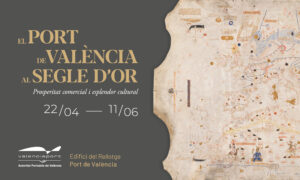
The exhibition, organised by the Port Authority of Valencia (APV), will highlight the importance of the Port in the economic, cultural and commercial growth of Valencia during this period
It can be visited free of charge between 22 April and 11 June between 11.00 a.m. and 7.00 p.m.
The exhibition will present products of the period, trade routes, the structure of the Port, navigation instruments in the 15th century and the artistic trends of this period
The Port of Valencia played a fundamental role in the economic and cultural development of the city at the height of the Renaissance and the Crown of Aragon. It was a strategic space for the emergence and consolidation of the Valencian Golden Age, a period in our history that the Port Authority of Valencia (PAV) wishes to highlight with the exhibition ‘El Port de València al Segle d’Or. Commercial prosperity and cultural splendour’, which will be held in the Clock Building between 22 April and 11 June. A free exhibition, which can be visited every day, including public holidays, between 11.00h and 19.00h so that citizens and tourists can learn about some of the keys to this golden age in the history of València.
Around 1400, Valencia began an unstoppable economic and commercial growth thanks to the strategic location of its port on the Mediterranean, its fertile market garden, excellent quality craftsmanship and an area of territorial influence that produced agricultural surpluses for export. The Port of Grau de València became an unavoidable stopover on the Mediterranean routes and their stopovers with Atlantic Europe. The city was a destination for the inland population, craftsmen, businessmen and foreign traders who positioned it as the most important municipality in the Crown of Aragon. During the 15th century, the prosperity of maritime trade transformed the city, generated prosperity and attracted a great projection for the arts and literature. A century of extraordinary commercial wealth and cultural splendour that has gone down in history as the Valencian Golden Age.
All of this will be included in ‘El Port de València al Segle d’Or. Commercial prosperity and cultural splendour’, an exhibition organised by Valenciaport to commemorate a fundamental part of the history of the Valencian Community. An artistic, didactic and historical event that is part of the PAV’s commitment to bring culture closer to the public with a series of free exhibitions on different themes held in the Clock Building. The iconic venue has become a point of reference for locals and tourists who find its doors open to enjoy the activities it hosts throughout the year.
Four sections to explore the València of the Golden Age
In the exhibition ‘El Port de València al Segle d’Or’ you will discover the trade routes of the time, the situation and port infrastructures, the main goods that entered and left Valencia by sea, emblematic buildings of the city of this period, artistic trends,… The exhibition is divided into several sections that take us back in time to place us in the middle of medieval València.
- Sailing and trading in the Mediterranean
In this section you can see portulan charts, a model of the coca de Mataró and a 15th century astrolabe from the Maritime Museum of Barcelona.
The main trade routes on which the port of Valencia was an unavoidable stopover during the 15th century are explained, as well as the main export and import products.
- The Vilanova of Grau de la Mar
This section will explain its function since its foundation in 1249 was that of supplying and defending the port, the Grau and the city of Valencia. Visitors will be able to learn about the port functions of the Grau, as well as its organisation through models of the Atarazanas or the bastion.
- The cultural splendour of the city
This area will be dedicated to showing the main commercial scenarios such as the Mercat and the Lonja, where the Consulado del Mar (Sea Consulate) was located. A large area will be devoted to the main luxury crafts produced in the city, such as silks and ceramics from Manises and Paterna, products that were highly sought after by royalty and the most important noble families of medieval Europe.
The influences of the artistic trends in vogue in Europe reached Valencia, where craftsmen and artists from different origins settled in a cultural exchange fostered by communication and maritime trade.
The role played by the establishment of the printing press in València will be shown, thanks to international trade connections and the dissemination of Valencian culture and literature by authors such as Joanot Martorell, Ausiàs March and Isabel de Villena.
- Past and present of the city of Valencia
A present-day map of the city will show the emblematic places and buildings of the Valencian Golden Age and their current functions, an invitation to explore the past of the commercial prosperity and cultural splendour of 15th-century València.

